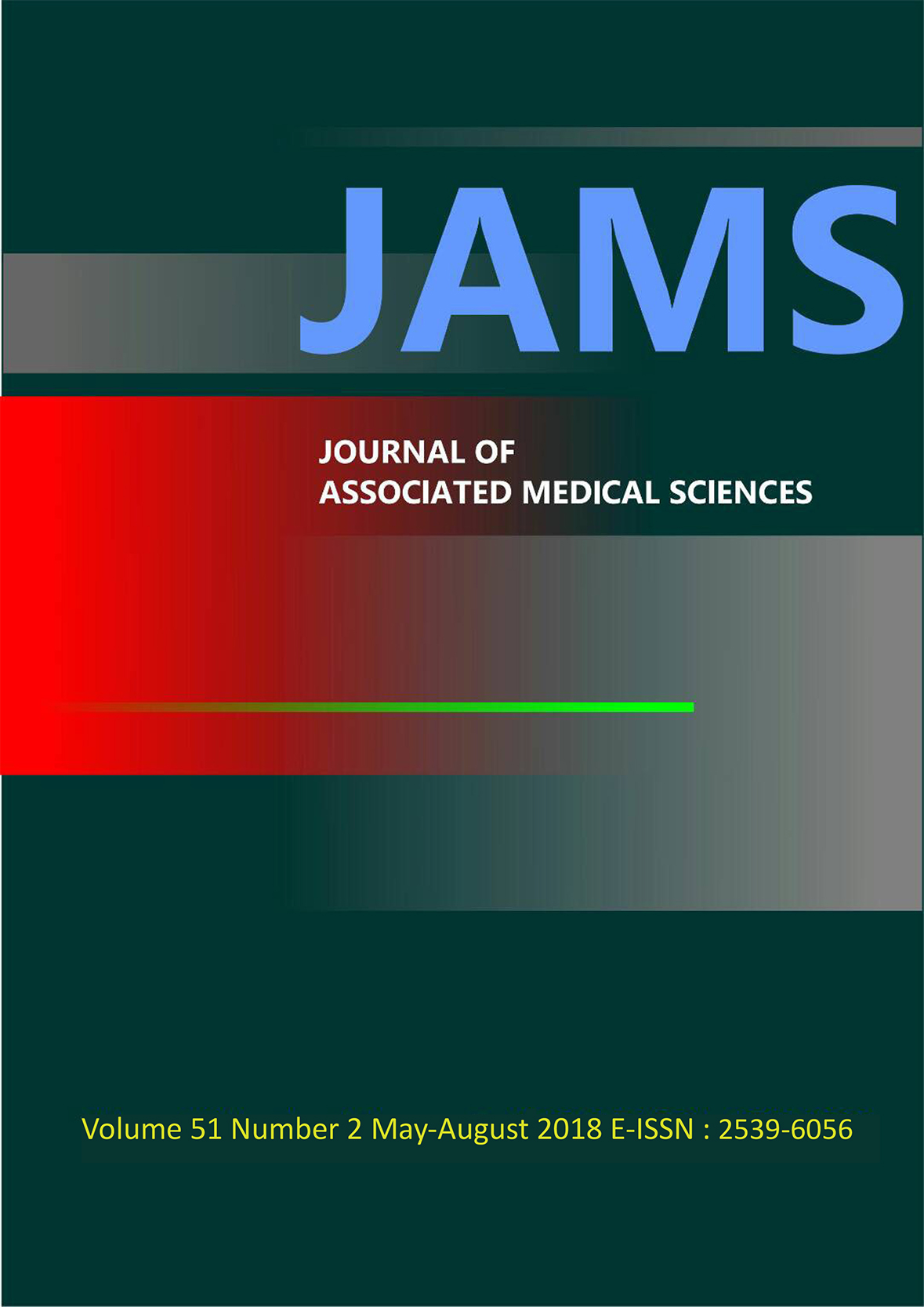Prevalence of high-risk human papillomavirus infection detected by real-time polymerase chain reaction in Lampang Cancer Hospital
Main Article Content
Abstract
Background: Human papillomaviruses (HPV) infection can cause diseases such as warts, benign and tumors including cervical cancer. Latest, recent statistical results have revealed that cervical cancer is ranked the second highest of cancer diseases in Lampang Cancer Hospital (LPCH). Since 2013, HPV high risk (HR) test has been used to screen cervical cancer in combination with liquid-based cytology test in LPCH for early detection of cervix abnormalities.
Objectives: To report the prevalence of HR-HPV infection detected by real-time polymerase chain reaction (PCR) method in LPCH during 1st October 2014 to 30th September 2016.
Materials and methods: HR-HPV testing was done by real-time PCR technique using HPV-Risk assay kit. Cervical cell PAP smears were collected and prepared by liquid-based cytology system (PathTezt) and interpretation followed the Bethesda system.
Results: Results of the study detected 305 out of 4,789 women who participated in the screening program being positive with HR-HPV viruses related to cervical cancer. This represented 6% of positive cases. Of the 305 positive cases, 72 were infected with HPV 16 and 18 genotype which are the most common causes of cervical cancer.
Conclusion: Prevalence of HR-HPV infection detected by real time-PCR was no different from those detected by PCR and DNA hybridization technique. Advantages in using real time-PCR are primarily, time and cost savings which are of essential importance in laboratory operations. An added benefit in this new technique, is the greater degree of accuracy where the E7 region is probed instead of the L1 region where mis-detection is common.
Article Details

This work is licensed under a Creative Commons Attribution-NonCommercial-NoDerivatives 4.0 International License.
Personal views expressed by the contributors in their articles are not necessarily those of the Journal of Associated Medical Sciences, Faculty of Associated Medical Sciences, Chiang Mai University.
References
[2] Daoprasert K, Pawong A, Sangkam S, Praditkay M, Suwannamuang P, Wannoi N, et al. Hospital-Based Cancer Registry, 2015 (in Thai).
[3] Balasubramanian A, Kulasingam SL, Baer A, Hughes JP, Myers ER, Mao C, et al. Accuracy and cost-effectiveness of cervical cancer screening by high-risk human papillomavirus DNA testing of self-collected vaginal samples. J Low Genit Tract Dis. 2010; 14(3): 185-95.
[4] Meijer CJ, Berkhof J, Castle PE, Hesselink AT, Franco EL, Ronco G, et al. Guidelines for human papillomavirus DNA test requirements for primary cervical cancer screening in women 30 years and older. Int J Cancer. 2009; 124(3): 516-20.
[5] Moosa NY, Khattak N, Alam MI, Sher A, Shah W, Mobashar S, et al. Comparison of cervical cell morphology using two different cytology techniques for earlydetection of pre-cancerous lesions. Asian Pac J Cancer Prev. 2014; 15(2): 975-81.
[6] Simms KT, Hall M, Smith MA, Lew JB, Hughes S, Yuill S, et al. Optimal Management Strategies for Primary HPV Testing for Cervical Screening: Cost-Effectiveness Evaluation for the National Cervical Screening Program in Australia. PLos One. 2017; 12(1): e0163509.
[7] Rijksinstituut voor Volksgezondheid en Milieu. Cervical cancer screening in the Netherlands. [Publication 2014 Jan 20]. Avialable from: https://www.rivm.nl/en/Documents_and_publications/Common_and_Present/Newsmessages/2014/Cervical_cancer_screening_in_the_Netherlands (in Dutch)
[8] National Screening Unit. Primary HPV testing consultation. [updated 2016 March 9]. Avialable from: https://www.nsu.govt.nz/health-professionals/national-cervical-screening-programme/primary-hpv-screening/primary-hpv-testing
[9] Wise J (2012) Pilot study will assess whether HPV test should replace smears to screen for cervical cancer. BMJ 344: e3744. pmid:22641810
[10] Hesselink AT, Berkhof J, van der Salm ML, van Splunter AP, Geelen TH, van Kemenade FJ, et al. Clinical validation of the HPV-risk assay, a novel real-time PCR assay for detection of high-riskhuman papillomavirus DNA by targeting the E7 region. J Clin Microbiol. 2014 Mar; 52(3): 890-6.
[11] Fongmoon D, Nakong M, Lalitwongsa S, Keyoonwong W. Prevalence and genotypic distribution of high-risk human papillomavirus infection among women who screened for cervical cancer at Lampang Cancer Hospital. Bull Chiang Mai Assoc Med Sci. 2015 Sep; 48(3): 231-40.
[12] Clifford GM, Vaccarella S, Franceschi S, Tenet V, Umulisa MC, Tshomo U, et al.Comparison of Two Widely Used Human Papillomavirus Detection and Genotyping Methods, GP5+/6+-Based PCR Followed by Reverse Line Blot Hybridization and Multiplex Type-Specific E7-Based PCR. J Clin Microbiol. 2016 Aug; 54(8): 2031-8.
[13] Liu Y, Lu Z, Xu R, Ke Y. Comprehensive mapping of the human papillomavirus (HPV) DNA integration sites in cervical carcinomas by HPV capture technology. Oncotarget. 2016 Feb 2; 7(5): 5852-64.
[14] Das P, Thomas A, Mahantshetty U, Shrivastava SK, Deodhar K, Mulherkar R. HPV genotyping and site of viral integration in cervical cancers in Indian women. PLoS One. 2012; 7(7): e41012.
[15] Burd EM. Human Papillomavirus Laboratory Testing: the Changing Paradigm. Clin Microbiol Rev. 2016 Apr; 29(2): 291-319.
[16] Agorastos T, Chatzistamatiou K, Katsamagkas T, Koliopoulos G, Daponte A, Constantinidis T, et al. Primary screening for cervical cancer based on high-risk human papillomavirus (HPV) detection and HPV 16 and HPV 18 genotyping, in comparison to cytology. PLoS One. 2015 Mar 20; 10(3): e0119755.
[17] de Villiers EM, Wagner D, Schneider A, Wesch H, Munz F, Miklaw H, et al. Human papillomavirus DNA in women without and with cytological abnormalities: results of a 5-year follow-up study. Gynecol Oncol. 1992 Jan; 44(1): 33-9.


